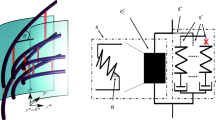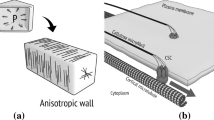Summary
To explain the generation mechanism of tree growth stresses in relation to time and location inhomogeneity in the secondary wall lignification, we made a theoretical discussion by using an analytical model. In this analysis, time dependence, which has not been explicitly considered in a conventional model, was introduced. This made us possible to simulate the generation process of the growth stresses as a time dependent phenomenon attendant upon the secondary wall maturation.
Analysis well explained the experimental results quantitatively on the assumption that a tensile stress originates in the cellulose microfibril as a bundle and a compressive stress are generated in the matrix skeleton during the secondary wall lignification. This verifies the propriety of “the unified hypothesis” proposed by Okuyama et al. quantitatively.
Similar content being viewed by others
References
Archer RR (1987) On the origin of growth stresses in trees.: Part 1. Micromechanics of the developing cambial cell walls. Wood Sci. Technol. 21:139–154
Archer RR (1989) On the origin of growth stresses in trees.: Part 2. Stresses generated in a tissue of developing cells. Wood Sci. Technol. 23:311–322
Bamber RK (1978) The origin of growth stresses. Proc. IUFRO conf Laguna, Philippines, contributed paper, pp 7
Barber NF (1968) A theoretical model of shrinking wood. Holzforschung 22:97–103
Boyd JD (1972) Tree growth stresses V.: Evidence of an origin in differentiation and lignification. Wood Sci. Technol. 6: 251–262
Meylan BA (1973) Compression wood force generation. NZ. J. For. Sci. 4:116
Okuyama T, Sasaki Y, Kikata Y, Kawai N (1981) The seasonal change in growth stresses in the tree trunk. J. Jpn. Wood Res. Soc. 27:350–355
Okuyama T, Kawai A, Kikata Y, Yamamoto H (1986) The growth stresses in reaction wood. Proc. XVIII IUFRO Congr., Yugoslavia, 249–260
Okuyama T, Yamamoto H (1992) Residual stresses in living tree. In: Fujiwara H et al. (Ed.): Residual stresses III — science and technology. pp 128–133. London: Elsevier Applied Science
Okuyama T (1993) Growth stresses in tree. J. Jpn. Wood Res. Soc. 39:747–756
Okuyama T, Yamamoto H, Yoshida M, Hattori Y, Archer RR (1994) Growth stresses in tension wood.: Role of microfibrils and lignification. Annales des Sciences Forestieres, 51:291–300
Okuyama T, Yoshida M, Yamamoto H (1995) An estimation of turgor pressure change as one of factors of growth stress generation in cell wall.: Diurnal change in tangential strain of inner bark. J. Jpn. Wood Res. Soc. 41:1070–1078
Terashima N (1990) A new mechanism for formation of a structurally ordered protolignin macromolecule in the cell wall of tree xylem. J. Pulp Paper Sci. 16:J150-J155
Timell TE (1986) Compression wood in gymnosperms 1, pp 623–706. Berlin: Springer-Verlag
Wardrop AB (1965) The formation and function of reaction wood. In: Cote W A Jr. (Ed.): Cellular ultrastructure of woody plants, pp 373–390. New York: Syracuse Univ. Press
Wilson BF (1981) The development of growth strains and stresses in reaction wood. In: Barnet, J. R. (Ed.): Xylem cell development, pp 275–290. Turnbridge Wells: Castle House Publication
Yamamoto H, Okuyama T (1988) Analysis of the generation process of growth stresses in cell walls. J. Jpn. Wood Res. Soc. 34:788–793
Yamamoto H, Okuyama T, Yoshida M, Sugiyama K (1991) Generation process of growth stresses in cell walls III.: Growth stress in compression wood. J. Jpn. Wood Res. Soc. 37:94–100
Yamamoto H, Okuyama T, Sugiyama K, Yoshida M (1992) Generation process of growth stresses in cell walls IV.: Action of the cellulose microfibril upon the generation of the tensile stresses. J. Jpn. Wood Res. Soc. 38:107–113
Yamamoto H (1993) Studies on generation process of growth stresses in xylem cell walls. Thesis, Nagoya University, pp 135
Yamamoto H, Okuyama T, Yoshida M (1993a) Generation process of growth stresses in cell walls V.: Model of tensile stress generation in gelatinous fiber. J. Jpn. Wood Res. Soc. 39:118–125
Yamamoto H, Okuyama T, Yoshida M (1993b) Method of determining the mean microfibril angle of wood over wide range by the improved Cave's method. J. Jpn. Wood Res. Soc. 39:375–381
Yamamoto H, Okuyama T, Yoshida M (1995) Generation Process of growth stresses in cell walls VI.: Analysis of the growth stress generation by using cell model having three layers (S1, S2, and I+P). J. Jpn. Wood Res. Soc. 41:1–8
Author information
Authors and Affiliations
Additional information
The author thanks Prof. T. Okuyama, Nagoya University, for his valuable advices and critical reading the manuscript, and Prof. D. Guitard, University of Bordeaux I, for his kind discussion.
Rights and permissions
About this article
Cite this article
Yamamoto, H. Generation mechanism of growth stresses in wood cell walls: roles of lignin deposition and cellulose microfibril during cell wall maturation. Wood Sci.Technol. 32, 171–182 (1998). https://doi.org/10.1007/BF00704840
Received:
Issue Date:
DOI: https://doi.org/10.1007/BF00704840




